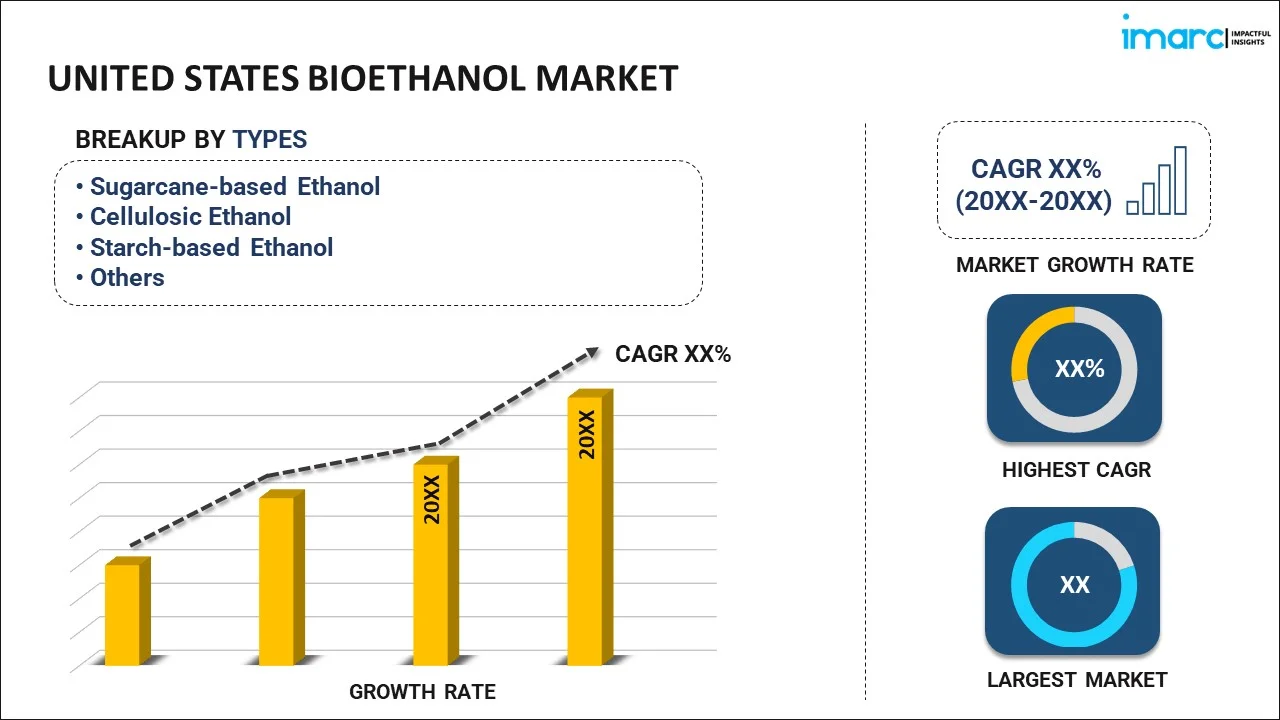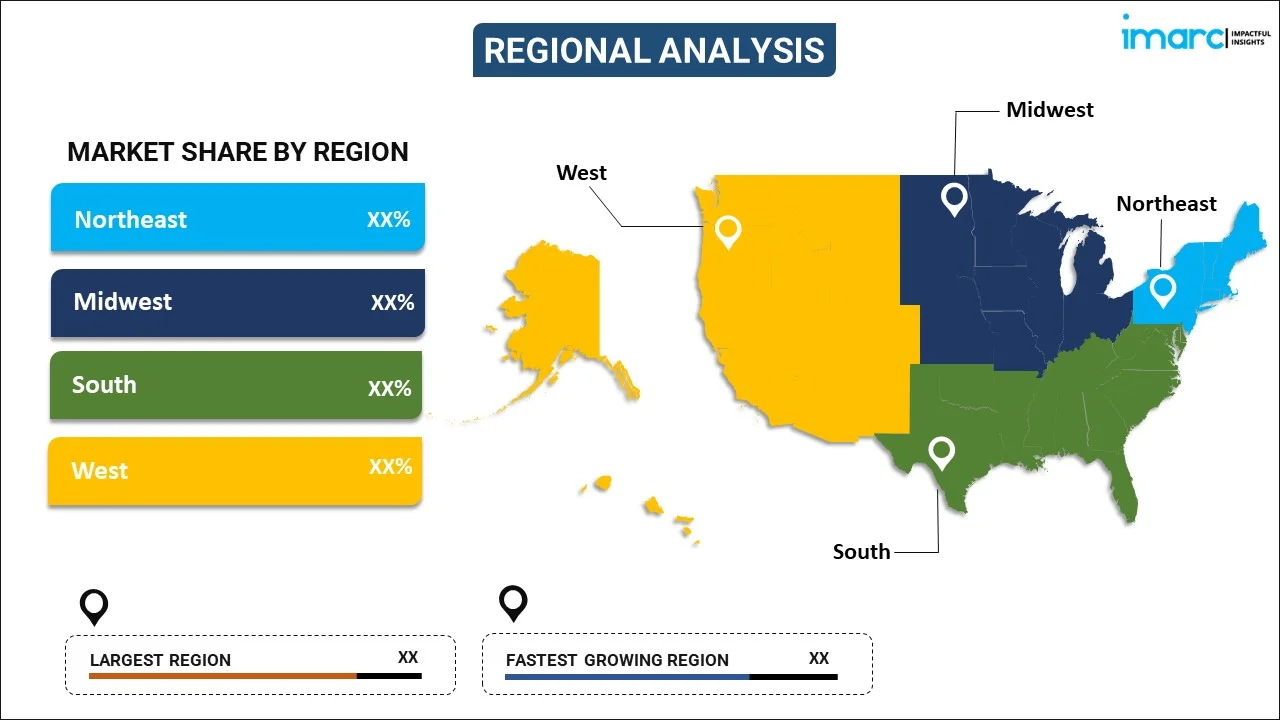
United States Bioethanol Market Report by Types (Sugarcane-based Ethanol, Cellulosic Ethanol, Starch-based Ethanol, and Others), Fuel Blend (E10, E20 and E25, E70 and E75, E85, and Others), Generation (First Generation, Second Generation, Third Generation), End Use Industry (Automotive and Transportation, Power Generation, Pharmaceutical, Food and Beverage, Cosmetics and Personal Care, and Others), and Region 2025-2033
Market Overview:
United States bioethanol market size is projected to exhibit a growth rate (CAGR) of 5.08% during 2025-2033. The development of eco-friendly fuel alternatives, on account of the rising consumer environmental concerns, is primarily driving the market growth across the country.
|
Report Attribute
|
Key Statistics
|
|---|---|
|
Base Year
|
2024 |
|
Forecast Years
|
2025-2033 |
|
Historical Years
|
2019-2024
|
| Market Growth Rate (2025-2033) | 5.08% |
Bioethanol, a clear and colorless liquid derived from biomass through hydrolysis and sugar fermentation or the chemical reaction of ethylene with steam, stands as an environmentally friendly alternative to conventional fuels. Notably biodegradable and less toxic, it mitigates environmental pollution, positioning itself as a prominent substitute for traditional fuels in road transport vehicles. Its seamless blending with petrol without necessitating modifications to engine designs yields a reduction in both greenhouse gas (GHG) emissions and air pollution. The current surge in research and development activities, particularly in the production of bioethanol fuel using municipal solid waste, is augmenting the demand for this sustainable energy source across the country.
United States Bioethanol Market Trends:
The United States bioethanol market is experiencing a transformative phase, shaped by key drivers and noteworthy trends that underscore the industry's commitment to sustainable and eco-friendly fuel alternatives. A major driver is the increasing emphasis on reducing carbon footprints and mitigating climate change. Additionally, technological advancements in bioethanol production processes are playing a pivotal role. Ongoing R&D activities focus on improving the efficiency of hydrolysis, sugar fermentation, and chemical reactions, contributing to enhanced bioethanol production capabilities in the United States. Besides this, the escalating demand for bioethanol as a flexible fuel source is rising, supported by its compatibility with existing infrastructure and internal combustion engines, which is bolstering the market growth. Furthermore, the circular economy approach is influencing the bioethanol market in the country, with a growing emphasis on using bioethanol derived from agricultural residues and municipal solid waste. This trend addresses concerns about resource efficiency and waste reduction, contributing to the sustainability of bioethanol as a fuel source. Additionally, the increasing focus of key players on reducing environmental impact, technological innovation, and embracing circular economy principles showcase a commitment to fostering a greener and more sustainable future for the country's energy landscape. This, in turn, will bolster the market growth in the coming years.
United States Bioethanol Market Segmentation:
IMARC Group provides an analysis of the key trends in each segment of the market, along with forecasts at the country level for 2025-2033. Our report has categorized the market based on type, fuel blend, generation, and end use industry.
Type Insights:

- Sugarcane-based Ethanol
- Cellulosic Ethanol
- Starch-based Ethanol
- Others
The report has provided a detailed breakup and analysis of the market based on the type. This includes sugarcane-based ethanol, cellulosic ethanol, starch-based ethanol, and others.
Fuel Blend Insights:
- E10
- E20 and E25
- E70 and E75
- E85
- Others
A detailed breakup and analysis of the market based on the fuel blend have also been provided in the report. This includes E10, E20 and E25, E70 and E75, E85, and others.
Generation Insights:
- First Generation
- Second Generation
- Third Generation
The report has provided a detailed breakup and analysis of the market based on the generation. This includes first generation, second generation, and third generation.
End Use Industry Insights:
- Automotive and Transportation
- Power Generation
- Pharmaceutical
- Food and Beverage
- Cosmetics and Personal Care
- Others
A detailed breakup and analysis of the market based on the end use industry have also been provided in the report. This includes automotive and transportation, power generation, pharmaceutical, food and beverage, cosmetics and personal care, and others.
Regional Insights:

- Northeast
- Midwest
- South
- West
The report has also provided a comprehensive analysis of all the major regional markets, which include Northeast, Midwest, South, and West.
Competitive Landscape:
The market research report has also provided a comprehensive analysis of the competitive landscape. Competitive analysis such as market structure, key player positioning, top winning strategies, competitive dashboard, and company evaluation quadrant has been covered in the report. Also, detailed profiles of all major companies have been provided.
United States Bioethanol Market Report Coverage:
| Report Features | Details |
|---|---|
| Base Year of the Analysis | 2024 |
| Historical Period | 2019-2024 |
| Forecast Period | 2025-2033 |
| Units | Million USD |
| Scope of the Report | Exploration of Historical Trends and Market Outlook, Industry Catalysts and Challenges, Segment-Wise Historical and Future Market Assessment:
|
| Types Covered | Sugarcane-based Ethanol, Cellulosic Ethanol, Starch-based Ethanol, Others |
| Fuel Blends Covered | E10, E20 and E25, E70 and E75, E85, Others |
| Generations Covered | First Generation, Second Generation, Third Generation |
| End Use Industries Covered | Automotive and Transportation, Power Generation, Pharmaceutical, Food and Beverage, Cosmetics and Personal Care, Others |
| Regions Covered | Northeast, Midwest, South, West |
| Customization Scope | 10% Free Customization |
| Post-Sale Analyst Support | 10-12 Weeks |
| Delivery Format | PDF and Excel through Email (We can also provide the editable version of the report in PPT/Word format on special request) |
Key Questions Answered in This Report:
- How has the United States bioethanol market performed so far and how will it perform in the coming years?
- What has been the impact of COVID-19 on the United States bioethanol market?
- What is the breakup of the United States bioethanol market on the basis of type?
- What is the breakup of the United States bioethanol market on the basis of fuel blend?
- What is the breakup of the United States bioethanol market on the basis of generation?
- What is the breakup of the United States bioethanol market on the basis of end use industry?
- What are the various stages in the value chain of the United States bioethanol market?
- What are the key driving factors and challenges in the United States bioethanol?
- What is the structure of the United States bioethanol market and who are the key players?
- What is the degree of competition in the United States bioethanol market?
Key Benefits for Stakeholders:
- IMARC’s industry report offers a comprehensive quantitative analysis of various market segments, historical and current market trends, market forecasts, and dynamics of the United States bioethanol market from 2019-2033.
- The research report provides the latest information on the market drivers, challenges, and opportunities in the United States bioethanol market.
- Porter's five forces analysis assist stakeholders in assessing the impact of new entrants, competitive rivalry, supplier power, buyer power, and the threat of substitution. It helps stakeholders to analyze the level of competition within the United States bioethanol industry and its attractiveness.
- Competitive landscape allows stakeholders to understand their competitive environment and provides an insight into the current positions of key players in the market.
Need more help?
- Speak to our experienced analysts for insights on the current market scenarios.
- Include additional segments and countries to customize the report as per your requirement.
- Gain an unparalleled competitive advantage in your domain by understanding how to utilize the report and positively impacting your operations and revenue.
- For further assistance, please connect with our analysts.
 Inquire Before Buying
Inquire Before Buying
 Speak to an Analyst
Speak to an Analyst
 Request Brochure
Request Brochure
 Request Customization
Request Customization




.webp)




.webp)












